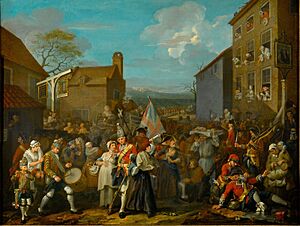Foundling Museum facts for kids

The museum's façade, Brunswick Square. A statue of Thomas Coram is to the far right.
|
|
| Lua error in Module:Location_map at line 420: attempt to index field 'wikibase' (a nil value). | |
| Established | 2004 |
|---|---|
| Location | Brunswick Square London, WC1 United Kingdom |
| Type | Art gallery, Museum |
| Visitors | c. 40,000 per year |
| Public transit access | |
The Foundling Museum in London is a special place. It tells the amazing story of the Foundling Hospital. This hospital was Britain's very first home for babies and children who needed help. The museum has two important collections. One is the Foundling Hospital Collection, which is full of items from the hospital's past. The other is the Gerald Coke Handel Collection, which has many things about the famous composer George Frideric Handel.
The museum reopened in June 2004 after a big makeover. It shows how the Foundling Hospital helped children. Today, the hospital continues its work as the charity Coram. Famous artists like William Hogarth and musicians like Handel were important to the hospital's story. The museum celebrates how creative people have helped children for over 275 years.
Contents
The Foundling Hospital's Story
How the Hospital Started
The Foundling Hospital was created by a kind man named Thomas Coram in 1739. He worked very hard for 17 years to make it happen. Finally, King George II gave him permission to open it. This made it the UK's first charity for children. It was built in Bloomsbury, a part of London.
By the 1920s, London had grown a lot. The hospital was no longer away from the city's busy streets. So, the people in charge decided to move the hospital. They built a new, modern place in Berkhamsted. In 1926, the old hospital building in Bloomsbury was sold and taken down.
The Museum's Home Today
Between 1935 and 1937, the Thomas Coram Foundation built a new main office. This new building is at 40 Brunswick Square. It used parts and designs from the original Foundling Hospital. This helped keep the history alive.
The Foundling Museum became its own charity in 1998. To keep and show the collections, a deal was made in 2002. The charity Coram lent the artworks to the museum. This allowed the museum to raise money to buy them over 25 years. The building was updated between 2003 and 2004.
What You Can See at the Museum
The museum looks after two main collections. These are the Foundling Hospital Collection and the Foundling Museum Collection. The second one includes the Gerald Coke Handel Collection. These collections show things from the 1700s all the way to the 1900s. This helps visitors connect the past with today.
Famous Artworks
The Foundling Hospital Collection has art by some of Britain's best artists from the 1700s. These include William Hogarth, Thomas Gainsborough, Joshua Reynolds, and others. These artists gave their paintings and sculptures to help the hospital. This made the hospital like the UK's first public art gallery.
The museum also has everyday items from the hospital. There are old books, papers, music, photos, and recordings of people's stories. You can also see clocks, furniture, and parts of rooms. Many of these were made especially for the hospital.
Touching Tokens of Hope
Some of the most moving items are the Foundling Hospital tokens. These were small things like coins, buttons, jewelry, or poems. Mothers left these with their babies when they brought them to the hospital. The tokens were a way to identify the child if the mother ever came back for them. Sadly, most children never saw their mothers again. These tokens are now cared for by the museum.

Special Rooms to Explore
The Committee Room is a recreated room from the original hospital. This is where mothers would be interviewed before leaving their babies. Today, it shows paintings, sculptures, and furniture. You can see Hogarth's famous painting, The March of the Guards to Finchley. There are also paintings by Emma Brownlow showing scenes from the children's lives.
The Picture Gallery is a copy of the original gallery. It has paintings of the hospital's leaders and important people. These include William Hogarth's great painting of Thomas Coram. You can also see portraits by Allan Ramsay and Joshua Reynolds.
The Court Room was where the hospital's leaders held meetings. They also entertained important guests here. This room has beautiful Rococo style decorations. The ceiling has amazing plasterwork given by William Wilton. Paintings here include Hogarth's Moses before Pharaoh’s Daughter and a picture by Gainsborough.
The Handel Collection
The top floor of the museum holds the Gerald Coke Handel Collection. Here, you can learn about Handel's connection to the Foundling Hospital. You can see his will and many of his music papers. There are also books, artworks, and old concert programs. A special copy of Handel's Messiah is also on display. You can even sit in special chairs that play nine hours of Handel's music!
See also
 In Spanish: Museo Foundling para niños
In Spanish: Museo Foundling para niños

